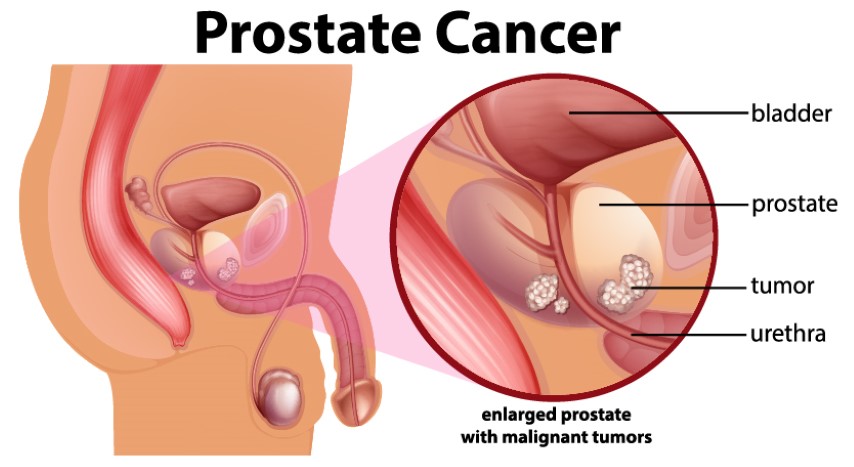The prostate gland is a small gland found only in males. It produces the seminal fluid that helps transport the sperms. The prostate gland is located below the bladder and in front of the rectum. As the name itself suggests, prostate cancer begins at the prostate gland, when the cells grow and multiply uncontrollably.
Prostate cancer is one of the most common types of cancer, and it may show no signs or symptoms in the early stages. However, patients with prostate cancer have higher chances of complete recovery if the cancer is detected early.
Symptoms of Prostate Cancer
As mentioned above, prostate cancer does not show any signs or symptoms during the earlier stages. Some common symptoms visible during the advanced stage of prostate cancer are:
- Trouble urinating, or the need to urinate more often than usual
- Blood present in the urine
- Blood in the semen
- Erectile dysfunction
- Pain in the bones – especially the hips, spine, and ribs
- A feeling of weakness/numbness in the feet
- Loss of weight
While most of these signs and symptoms may point to several other underlying conditions or diseases, it is necessary to talk to your healthcare provider if these symptoms are persistent or continue to worsen.
What causes prostate cancer?



Though the causes of prostate cancer remain unclear, it is known prostate cancer occurs when the cells in the prostate mutate. The mutation causes cells to grow and multiply rapidly, forming abnormal cells. The abnormal cells continue living, while the healthy cells die. These growing abnormal cells form a tumor and invade the nearby tissues or organs. Gradually, these abnormal cells also spread to the other parts of the body, causing cancer to grow.
Risk Factors of Prostate Cancer
Several factors can increase the risk of prostate cancer, such as:
Age: The risk of prostate cancer increases with age. Prostate cancer is more prevalent among men over the age of 50.
Ethnicity: For reasons unknown and undetermined, prostate cancer is more common among men of African-American descent. As per to urology.org, African-American men tend to get diagnosed with prostate cancer at an earlier age, and the cancer is likely to be aggressive in growth.
Family History: Men with a family history of prostate cancer have higher chances of being diagnosed with the same. A strong family history of breast cancer can also increase the chances of one developing prostate cancer.
Obesity: People who are obese have higher chances of developing prostate cancer, compared to those who maintain a healthy weight.
Prostate Cancer Diagnosis
If your doctor suspects that you might have prostate cancer, he might enquire about your symptoms such as urinary and sexual problems. He might also ask you about possible risk factors such as your family history to analyze the chances of you developing prostate cancer. after this, the doctor will run several diagnostic tests to diagnose the disease:
Digital Rectal Exam (DRE): During this, the doctor might insert a gloved finger into your rectum to examine the prostate, and feel for any bumps or hardened areas. If the doctor finds any abnormalities in the shape or size of the gland, he may advise further tests.
PSA Blood Test: A blood sample is taken and tested for PSA. PSA stands for Prostate-specific Antigen, which is a protein produced by the prostate gland. It is normal for a small amount of PSA to be found in your bloodstream. However, if it is higher than usual, it may be an indication of prostate cancer.
Ultrasound: During this test, a small probe is inserted into the rectum, and uses soundwaves to create images of the prostate gland.
MRI: Magnetic Resonance Imaging (MRI) scan may be suggested by your doctor to create a more detailed picture of your prostate gland.
Biopsy: The doctor may also collect a sample of cells in your prostate gland to check for signs of cancerous cells. This procedure is known as a prostate biopsy. A thin needle is inserted into the prostate to collect a sample of the tissue.
If you are diagnosed with prostate cancer, the doctor may use tests such as ultrasound, CT scan, or MRI to determine the stage of cancer.
Treating Prostate Cancer
The treatment for prostate cancer depends on how aggressive the cancer is and the extent it has spread. The right treatment option will also be chosen depending on the side effects and their impact on overall health.
Surgery: This involves removing the prostate gland, along with some nearby tissues and lymph nodes. Surgery is usually performed when the cancer is confined to the prostate. It may also be used to treat advanced prostate cancer combined with other treatment methods.
Radiation Therapy: This involves using high-powered radiation to kill the cancerous cells. This can be performed externally (external beam radiation) or internally (brachytherapy), by placing radiation sources in the prostate tissue.
Cryotherapy: This treatment involves using extremely cold gases to freeze the prostate tissue. After this, the tissue is allowed to thaw, and the procedure is repeated.
Hormone Therapy: This treatment stops the body from producing testosterone, the male hormone. Since prostate cancer cells rely on testosterone to grow, cutting the hormone supply may cause the cancerous cells to die.
Chemotherapy: This therapy uses drugs to kill the rapidly growing cancerous cells. Chemotherapy is usually used when cancer has spread to the other organs and areas of the body.
Immunotherapy: As the name itself suggests, this therapy involves using the immune system to fight cancer cells. The immune system usually does not attack cancer cells as they produce proteins that help protect the cancer cells. Immunotherapy interferes with this process.
Targeted Therapy: This treatment emphasizes the abnormalities present in the cancerous cells. Targeted therapy blocks and combats these abnormalities, causing the cancer cells to die.
Though several factors increase the risk of developing prostate cancer, early detection and following a healthy lifestyle can help nip prostate cancer in the bud. Though certain risks such as age, family history, and ethnicity cannot be avoided, other factors such as obesity can be avoided by maintaining a healthy diet and exercising regularly. Talk to your healthcare provider immediately if you notice certain symptoms and take the necessary precautions!





Comments are closed.